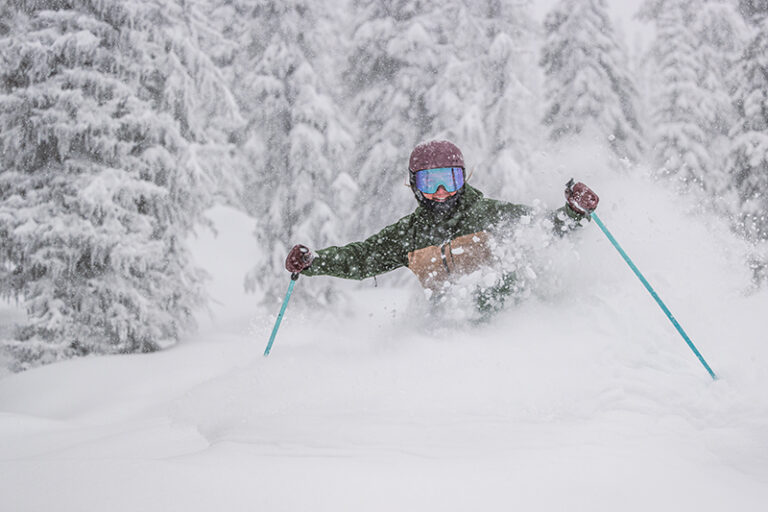David Blaine, local chef and cyclist, recently returned from competing in the Great Divide Mountain Bike Race, an endurance race in which the riders are self-supported along a 2,490-mile course from Canada to Mexico.
Imagine: You are 140 miles from the next place you’ll see another person, and you’re confident that the bike you’re riding won’t break, the legs you’re pedaling with won’t give out, and that you have the gear to survive if they do.
“Distance riding is my kind of riding—I can’t wheelie or jump my bike, and I like going uphill sometimes rather than downhill,” Blaine says. “Longer distances fit my mentality better.”
Blaine chose the GDMBR because “I’ve always been competitive but didn’t always race, so I was attracted to this less-structured race: it’s a mutual agreement to follow the same route and follow the same rules.”
And just how does one get geared up for such a staggering endurance challenge?
Bike: An Independent Fabrications Steel Deluxe 29er custom frame. “It was my first custom bike, and it made a world of difference to have the bike fit to me.”
“With a single speed bike, it’s really important to have good body position for climbing hills—I like being able to get behind the pedals, because I climb better when I can push forward.” The bike, he says, “rides like a smaller bike but still with the ability to fit bigger wheels.”
Wheels: DTSwiss tk7.1. “They’re not the lightest, but they’re made with Phil Wood hubs, which are pretty much indestructible. That was a big factor in all my gear choices: durability.”
Handlebars: Surly Torsion bar with Ergon grips. “It’s steel, so it has more flexibility and it absorbs more vibrations, and it was very wide (26 inches), giving me a large cockpit,” he says, which accommodated his need for progress tracking and navigation aides.
“I was a little jealous of the aero bars [the more popular choice among competitors] on the flat sections because it’s a way to take pressure off my back and hands, and be able to mix it up a bit.”
Seat: The WTB Laser V Saddle. “It’s almost the defacto saddle in endurance racing,” he says. Blaine planned to use a Koobi saddle to get “more suspension on a route where people complain about the washboard roads tearing up their hands and their backsides” but he broke two while training. For the race, “I went back to the saddle I knew I could trust.”
Gear bags: Instead of the traditional rack with panniers, Blaine used a custom set of bags by Carousel Design Works. “It’s lighter because the bags weigh less than a rack would, and they’re built in a way that allows more normal riding.” He compartmentalized his gear within the bags using lightweight dry bags by Sea to Summit. “I almost could have used more harness-type bags to attach the dry bags to the frame,” he says.
Clothes: Two pairs of bike shorts, two pairs of socks, a sleeveless shirt, and one jersey. He also carried a lightweight Smartwool shirt and tights to wear while sleeping. “Being able to get out of those clothes and get clean was huge,” says Blaine.
He also carried a two-ounce O2 jacket and heavy duty rain pants.
Overnight: Black Diamond’s Light Saber bivy, a Mountain Hardwear down sleeping bag, and a Thermarest pad. “And earplugs,” he adds, “my secret weapon.”
Hydration: “The biggest challenge is how to carry all the water you need, because with the bags on the bike, you’re blocking your normal water bottle carrier locations.”
He used a Chlorine Dioxide liquid treatment, Klear Water, which works faster than the traditional tablets. In hindsight, he says, “A filter seems like a better idea because your water bottles never actually have to touch the stream and only one part of the filter actually goes in the water, so it’s a lot easier to stay hygienic.”
Hydration proved to be the weakest link in Blaine’s preparations—he had to be hospitalized upon his arrival in Steamboat Springs, CO, due to a water-borne illness and had to abandon the race.
Nutrition: “There was a lot of regrettable food along the way,” he says. “My normal diet of energy bars and nut-based foods quickly faded,” he says, and “I craved fruit and fresh things, which are tough to find at gas stations along the way, but for some reason they always seem to have those lunch-pack fruit cocktail cups.”
The largest portion of his caloric intake was binging when he arrived in towns like Butte, where he tasted his first Burger King Croissan’wich (he bought seven), and the dubious meal he was served in Atlantic City, WY, of undercooked omelet and hash browns. “I ate it nonetheless, because it was calories.”
“A better strategy might have been to go as fast as possible between the services along the way,” he says, planning stops only in towns where the food, restrooms, and motels would be more reliable.













